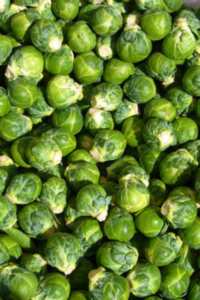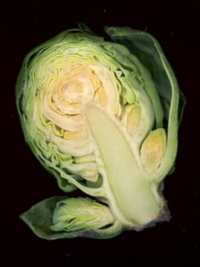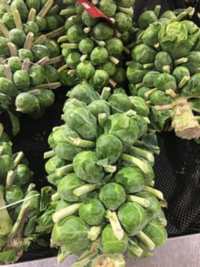Prestonpans Battlefield 'surrenders' to Brussels
Sound like Brexit, March 29th?
It's frequently the case that any setback these days is attributed to Brussels and the uncertainty surrounding Brexit, but that would be to mis-speak here. The Battle Trust's plan to farm rye on the battlefield as tendered to East Lothian Council was indeed foiled by Brussels, but on the grounds that our bid was too low!** The farmer who gained the lease is to crop Brussels sprouts. The rye we proposed was that traditionally grown in 1745!
So let's get serious about the victorious Brussels sprouts that will soon be well presented to all who walk or cycle the Waggonway. It's certainly a common crop and a very successful one across East Lothian. Usually best harvested after the first frost .. and often compulsory with turkey at Christmas or Thanksgiving.
  
It's not of course a vegetable that is loved by all; a Marmite vegetable really. Here's its nutritional analysis from Wikipedia:
Nutritional value of Brussel spout per 100 g (3.5 oz)
Energy 179 kJ (43 kcal)
Carbohydrates 8.95 g
Sugars 2.2 g
Dietary fibre 3.8 g
Fat 0.3 g
Protein 3.48 g
Vitamins Quantity %DV†
Vitamin A equiv.5% 38 μg
beta-Carotene 4%450 μg
lutein zeaxanthin 1590 μg
Thiamine (B1) 12% 0.139 mg
Riboflavin (B2) 8% 0.09 mg
Niacin (B3) 5% 0.745 mg
Pantothenic acid (B5) 6% 0.309 mg
Vitamin B6 17% 0.219 mg
Folate (B9) 15% 61 ìg
Choline 4% 19.1 mg
Vitamin C 102% 85 mg
Vitamin E 6% 0.88 mg
Vitamin K 169% 177 ìg
Minerals Quantity %DV†
Calcium 4% 42 mg
Iron 11% 1.4 mg
Magnesium 6% 23 mg
Manganese 16% 0.337 mg
Phosphorus 10% 69 mg
Potassium 8% 389 mg
Sodium 2% 25 mg
Zinc 4% 0.42 mg
Other constituents Quantity
Water 86 g
Units: μg = micrograms • mg = milligrams
IU = International units
  
Raw Brussels sprouts are 86% water, 9% carbohydrates, 3% protein, and contain negligible fat. In a 100 gram reference amount, they supply high levels (20% or more of the Daily Value, DV) of vitamin C (102% DV) and vitamin K (169% DV), with more moderate amounts of B vitamins, such as folate and vitamin B6); essential minerals and dietary fibre exist in moderate to low amounts.
Brussels sprouts, as with broccoli and other brassicas, contain sulforaphane, a phytochemical under basic research for its potential biological properties. Although boiling reduces the level of sulforaphane, neither steaming, microwave cooking, nor stir frying cause a significant loss.
Consuming Brussels sprouts in excess may not be suitable for people taking anticoagulants, such as warfarin, since they contain vitamin K, a blood-clotting factor. In one incident, eating too many Brussels sprouts led to hospitalization for an individual on blood-thinning therapy.
  
Forerunners to modern Brussels sprouts were probably cultivated in Ancient Rome. Brussels sprouts as they are now known were grown possibly as early as the 13th century in what is now Belgium.
The first written reference dates to 1587. During the 16th century, they enjoyed a popularity in the southern Netherlands that eventually spread throughout the cooler parts of Northern Europe.
Brussels sprouts grow in temperature ranges of 7–24 °C (45–75 °F), with highest yields at 15–18 °C (59–64 °F).[2] Fields are ready for harvest 90 to 180 days after planting. The edible sprouts grow like buds in helical patterns along the side of long, thick stalks of about 60 to 120 cm (24 to 47 in) in height, maturing over several weeks from the lower to the upper part of the stalk. Sprouts may be picked by hand into baskets, in which case several harvests are made of five to 15 sprouts at a time, or by cutting the entire stalk at once for processing, or by mechanical harvester, depending on variety. Each stalk can produce 1.1 to 1.4 kg (2.4 to 3.1 lb), although the commercial yield is about 900 g (2.0 lb) per stalk. Harvest season in temperate zones of the northern latitudes is September to March, making Brussels sprouts a traditional winter-stock vegetable. In the home garden, harvest can be delayed as quality does not suffer from freezing. Sprouts are considered to be sweetest after a frost.
Brussels sprouts are a cultivar group of the same species as broccoli, cabbage, collard greens, kale, and kohlrabi; they are cruciferous (they belong to the Brassicaceae family; old name Cruciferae). Many cultivars are available; some are purple in colour, such as 'Ruby Crunch' or 'Red Bull'.[5] The purple varieties are hybrids between purple cabbage and regular green Brussels sprouts developed by a Dutch botanist in the 1940s, yielding a variety with some of the red cabbage's purple colours and greater sweetness. The colour is lost with cooking!
  
… so, no sour grapes. The Trust hopes to work with the incoming farmer to undertake surface archaeology and explore the proposition that Thorntrees should grow again in a small copse at the spot where Colonel Gardiner was mortally wounded 274 years ago …
** ELC's official advice was:
"There were 8 offers submitted for the fields in question. There was a significant variation in rent offered with only one offer below the £5000 per annum we stipulated as the offers over price. Proposed crops again varied with grain, grass (hay/silage) and vegetables all featuring. All of the bids were from competent individuals with the necessary expertise.
"The rental value associated with growing vegetables is commonly higher than grain or grass and this was reflected in the offers submitted, consequently the successful offer was based on a proposed crop of brussel sprouts.
"[We] will pass your contact details onto the successful bidder and ask them to make contact re the archaeological insights you refer to."

Read more at: https://www.scotsman.com/lifestyle/historic-brussels-sprouts-crops-at-jacobite-battlefield-rejected-1-4900432
Published Date: March 6th 2019
|





